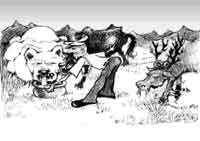Wolves feel the crunch
 the predator management programme in the managed forests of the us state of Alaska has aroused an age-old ecological debate. A report prepared by the National Research Council, the principal operating arm of the us National Academies of Sciences and Engineering, says that wildlife managers in Alaska may be able to temporarily increase populations of moose and caribou for hunters by killing off a large number of wolves in designated areas over a span of several years. But shortcomings of previous predator control programmes make it impossible to determine whether wolf or bear reduction programmes are effective in the long run, the report says.
the predator management programme in the managed forests of the us state of Alaska has aroused an age-old ecological debate. A report prepared by the National Research Council, the principal operating arm of the us National Academies of Sciences and Engineering, says that wildlife managers in Alaska may be able to temporarily increase populations of moose and caribou for hunters by killing off a large number of wolves in designated areas over a span of several years. But shortcomings of previous predator control programmes make it impossible to determine whether wolf or bear reduction programmes are effective in the long run, the report says.
Earlier programmes have not adequately considered the importance of habitat and weather changes. Nor have they included the analyses necessary to determine whether the programmes helped hunters or benefited the state's economy.
The council was called upon by Alaska to examine the scientific and economic bases of its predator management programmes, to identify loopholes, and to improve scientific understanding of the predator-prey interaction. "Except in cases where predator reduction has been substantial and sustained, it is difficult to determine whether most predator control experiments in Alaska have achieved their ultimate goal of improving hunting," said committee chairperson Gordon Orians, professor emeritus of zoology, University of Washington, Seattle. "By improving the design and monitoring of its predator control efforts, the state can close some of the gaps in understanding and help assure the public that it has considered all of the relevant information and interpreted it appropriately."
Wildlife management in Alaska includes any action designed to alter populations, such as culling, relocating or sterilising wolves and bears. Alaska has not conducted wolf or bear reduction programmes since 1994. Hunting has long been part of Alaska's culture, both for subsistence and for recreation.
Wolves and bears naturally limit moose and caribou populations. Reducing wolf numbers dramatically - by as much as 40 per cent or more for at least four - years has increased the availability of prey over the short term. However, the methods that have been used in the past to achieve such reductions, including hunting and poisoning, are no longer acceptable in Alaska, where voters approved a ban on aerial hunting last year. There is an inadequacy of data to assess the effectiveness of non-lethal methods, such as sterilisation or feeding programmes, to divert predators from prey, the report adds.
Despite considerable public investment in planning, designing and implementation of several predator control programmes in recent decades, they have not been designed and monitored to evaluate their success rates, the report says. Of the 11 predator reduction programmes in Alaska and Canada that were examined by the committee, only two assessed whether availability of prey improved after the predator population was reduced. In just five of the 11 cases was there any attempt to measure whether the population density of moose and caribou had increased.
